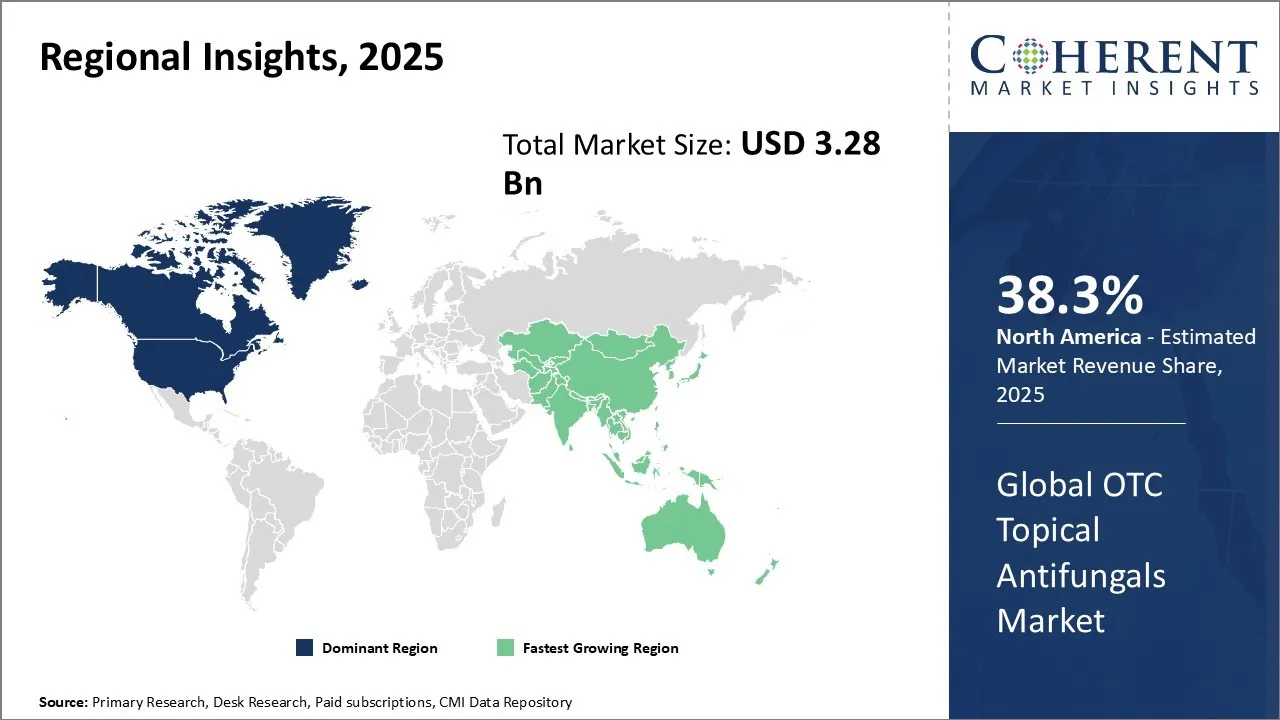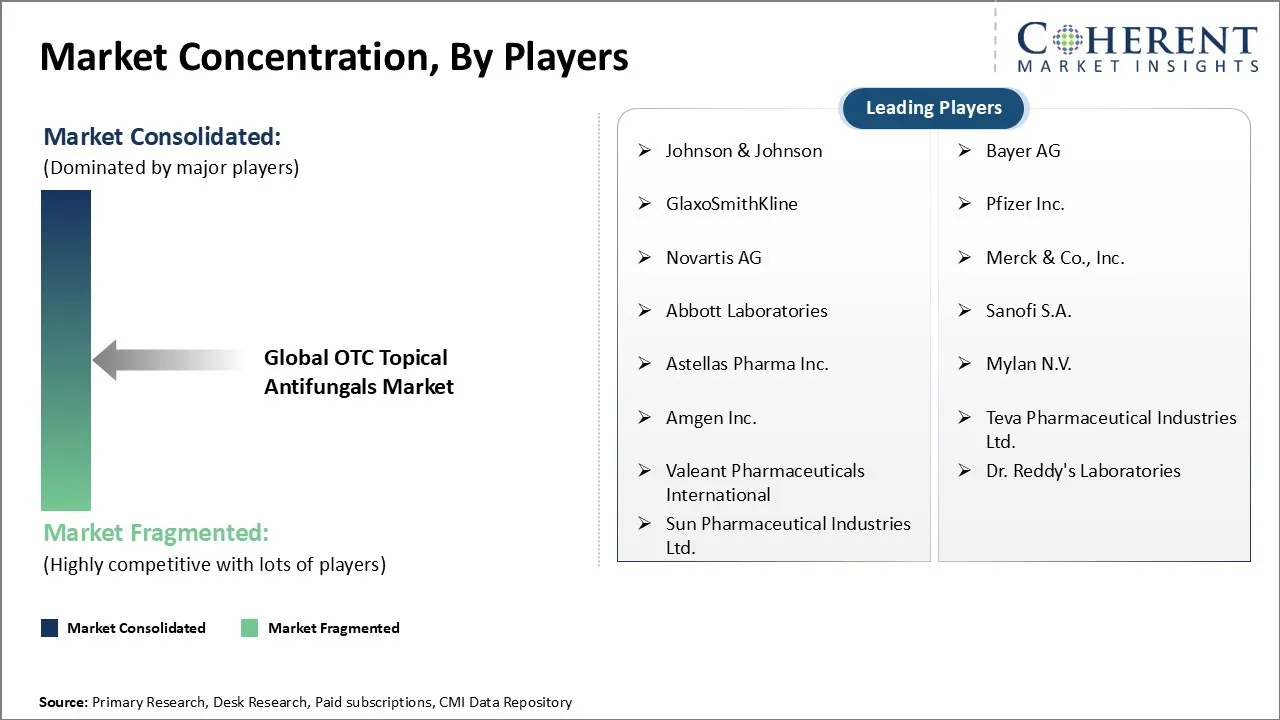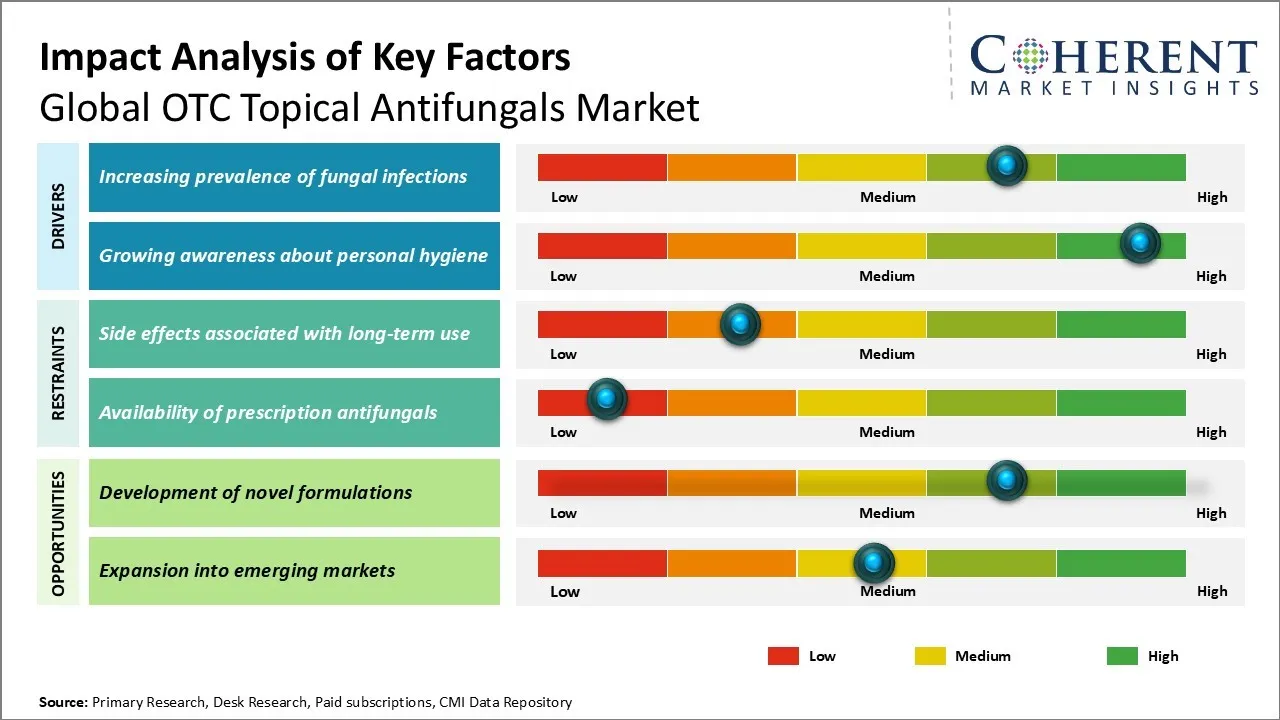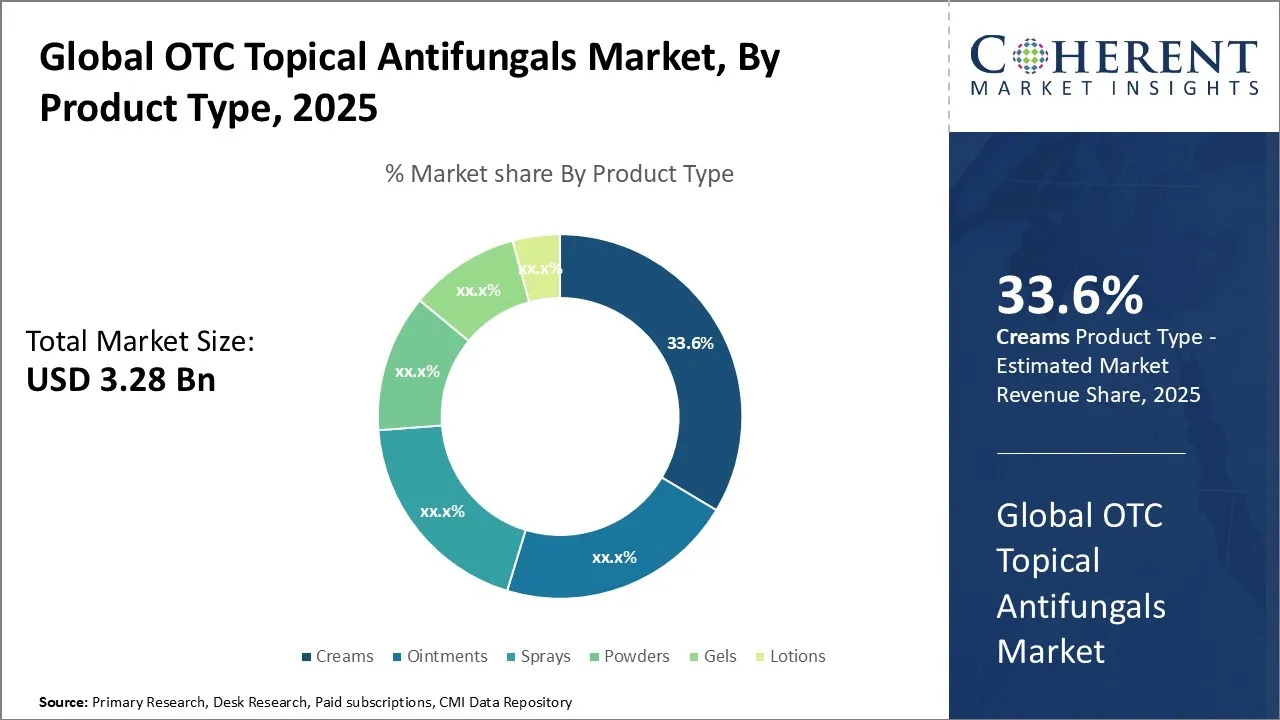Global OTC Topical Antifungals Market Size and Forecast – 2025 to 2032
The Global OTC Topical Antifungals Market is estimated to be valued at USD 3.28 Bn in 2025 and is expected to reach USD 4.90 Bn by 2032, exhibiting a compound annual growth rate (CAGR) of 5.9% from 2025 to 2032. The market demonstrates a steady growth trajectory, driven by factors such as the increasing prevalence of fungal infections, rising awareness about personal care & hygiene, and the growing availability of over-the-counter antifungal products.
Key Takeaways of the Global OTC Topical Antifungals Market
- By product type, creams are expected to hold the largest share of the market at 33.6% in 2025, attributed to their ease of application, non-greasy formulation, and effective delivery of active ingredients to infected areas.
- By active ingredient, clotrimazole is projected to account for the highest share at 32.2% in 2025, owing to its broad-spectrum antifungal properties and well-established efficacy against various fungal pathogens.
- By application, dermatophyte infections are anticipated to dominate with a 28.4% share in 2025, driven by their widespread occurrence and highly contagious nature.
- North America is expected to lead the market, holding a share of 38.3% in 2025. Asia Pacific is anticipated to be the fastest-growing region, with a market share of 30.2% in 2025.
Market Overview
The market trend for OTC topical antifungals is characterized by a shift towards more convenient and user-friendly product formulations such as sprays, gels, and lotions. Consumers are increasingly seeking fast-acting and easy-to-apply solutions for common fungal infections like athlete's foot, jock itch, and ringworm. Additionally, there is a growing demand for natural and organic antifungal products, as consumers become more health-conscious and environmentally aware. Manufacturers are responding to these trends by developing innovative products that cater to evolving consumer preferences and needs.
Current Events and Its Impact
|
Current Events |
Description and its impact |
|
Surge in Fungal Infections Due to Climate Change and Urbanization |
|
|
Post-Pandemic Rise in Hygiene Awareness |
|
Uncover macros and micros vetted on 75+ parameters: Get instant access to report
OTC Topical Antifungals Market Insights, By Product Type - Creams Dominate the Market due to Ease of Application and Efficacy
In terms of product type, the creams segment is expected to contribute the highest share of the market with 33.6% in 2025 owing to their ease of application, non-greasy texture, and ability to effectively deliver the active ingredients to the affected area. Creams are preferred by consumers due to their quick absorption and the cooling sensation they provide, which helps alleviate the itching and discomfort associated with fungal infections. Moreover, creams are suitable for various types of fungal infections, including athlete's foot, ringworm, and yeast infections, making them a versatile option for consumers.
The high market share of creams can also be attributed to their wide availability in various strengths and formulations, catering to different skin types and sensitivities. Manufacturers often incorporate additional ingredients, such as moisturizers and soothing agents, to enhance the overall user experience and promote skin healing. The convenience of using creams, combined with their proven efficacy in treating fungal infections, has led to their dominant position in the OTC topical antifungals market.
OTC Topical Antifungals Market Insights, By Active Ingredient - Clotrimazole Leads the Market due to its Broad-Spectrum Antifungal Activity
In terms of active ingredient, the clotrimazole segment is expected to contribute the highest share of the market with 32.2% in 2025 due to its broad-spectrum antifungal activity and proven efficacy against a wide range of fungal species. Clotrimazole is highly effective in treating common fungal infections, such as athlete's foot, jock itch, and ringworm, making it a popular choice among consumers and healthcare professionals alike.
The widespread availability of clotrimazole-based products in various forms, including creams, lotions, and sprays, has further contributed to its market dominance. Clotrimazole's over-the-counter status allows consumers to easily access the medication without the need for a prescription, promoting self-treatment, and reducing the burden on healthcare systems.
OTC Topical Antifungals Market Insights, By Application - Dermatophyte Infections Drive the Market due to their High Prevalence and Contagious Nature
In terms of application, the dermatophyte infections segment is expected to contribute the highest share of the market with 28.4% in 2025 due to their high prevalence and contagious nature. Dermatophyte infections, such as athlete's foot, ringworm, and jock itch, are caused by fungi that thrive in warm, moist environments and are easily spread through direct contact or exposure to contaminated surfaces.
The increasing incidence of dermatophyte infections can be attributed to various factors, including the growing participation in sports and fitness activities, the rising prevalence of obesity and diabetes, and the increasing use of public facilities such as swimming pools and gyms. These factors create favorable conditions for the growth and spread of dermatophyte fungi, leading to a higher demand for OTC topical antifungals.
Pricing Analysis for OTC Topical Antifungals Market
- The OTC topical antifungals market presents a broad pricing structure shaped by the type of active ingredient, formulation, and mode of application. Allylamines like Terbinafine are priced higher than most azoles, with a 15 g cream costing USD 33 and a 30ml spray reaching USD 67.20, indicating a premium for user-friendly formats. Azole-based products such as Clotrimazole and Miconazole offer more budget-friendly options, with cream formulations priced between USD 11 and USD 17. Additionally, other OTC alternatives like Tolnaftate and undecylenate are available in creams, powders, and sprays ranging from USD 5 to USD 15, offering affordable solutions for common fungal infections.
- Creams remain the most cost-effective and accessible treatment format, making them the dominant choice for consumers. However, the growing demand for convenience, portability, and non-messy application has led to the increasing popularity of sprays and powders, despite their relatively higher cost. This pricing flexibility across formats and active ingredients allows the market to cater to a wide range of consumer preferences and budgets. Overall, the OTC topical antifungals market balances affordability with innovation in product delivery, ensuring broad accessibility and market penetration.
Regional Insights

To learn more about this report, Download Free Sample
North America OTC Topical Antifungals Market Analysis and Trends
In North America, the dominance in the global OTC topical antifungals market with an estimated share of 38.3% in 2025 can be attributed to several factors. The region boasts a well-established healthcare infrastructure, coupled with high consumer awareness regarding fungal infections and available treatment options. The presence of major pharmaceutical companies, such as Johnson & Johnson and Bayer AG, further strengthens the market ecosystem. These companies actively invest in research and development, leading to the introduction of novel and effective topical antifungal products. Moreover, favorable government policies and regulations, including the Over-the-Counter (OTC) Drug Review process by the U.S. Food and Drug Administration (FDA), have streamlined the approval and availability of OTC topical antifungals in the region. The strong purchasing power of consumers and a growing emphasis on personal hygiene and self-care have also contributed to the market's dominance in North America.
Asia Pacific OTC Topical Antifungals Market Analysis and Trends
Meanwhile, the Asia Pacific region is expected to exhibit the fastest growth in the global OTC topical antifungals market with a share of 30.2% in 2025. The region's rapid economic development, rising disposable incomes, and increasing healthcare expenditure have fueled the demand for OTC topical antifungal products. The growing awareness about fungal infections and the availability of affordable treatment options has further propelled market growth. Countries like China and India, with their large populations and expanding middle class, present significant opportunities for market players. The presence of local pharmaceutical companies, such as Mankind Pharma and Cipla, has intensified competition and expanded product offerings in the region. Additionally, government initiatives to improve healthcare access and the rising prevalence of lifestyle-related fungal infections have contributed to the fast-paced growth of the OTC topical antifungals market in the Asia Pacific region.
Global OTC Topical Antifungals Market Outlook for Key Countries
U.S. OTC Topical Antifungals Market Trends
The U.S. market for OTC topical antifungals is characterized by a strong consumer preference for self-medication and a well-established distribution network. Major players like Bayer AG and Novartis AG have a significant presence in the country, offering a wide range of products. The market is driven by factors such as high prevalence of fungal infections, increasing health consciousness, and the availability of OTC products across various retail channels, including pharmacies and online platforms.
For instance, in January 2023, Sandoz, the generics and biosimilars division of Novartis AG, global pharmaceutical company acquired the well-known antifungal drug Mycamine from Astellas Pharma, a global pharmaceutical company based in Japan. This move strengthens Sandoz’s antifungal portfolio and expands its presence in the infectious disease segment.
China OTC Topical Antifungals Market Trends
China's market for OTC topical antifungals is witnessing significant growth due to the country's large population, rising disposable incomes, and increasing awareness about fungal infections. Local pharmaceutical companies, such as Sino Biopharmaceutical Limited and Topsun Pharmaceutical, play a crucial role in catering to the domestic demand. The market is further supported by government initiatives to improve healthcare access and the expansion of retail pharmacy chains.
For instance, in September 2022, China's National Medical Products Administration (NMPA), the regulatory body overseeing drug and cosmetic safety, released a new supplementary testing method—BJH 202202—for detecting eight prohibited antifungal agents in cosmetics, including Elubiol and Ornidazole. These ingredients, typically used in medical treatments, are banned in cosmetic formulations. The method applies to creams, lotions, and liquid skin products.
India OTC Topical Antifungals Market Trends
India continues to be a prominent market for OTC topical antifungals, driven by factors such as a large population, increasing healthcare expenditure, and growing self-medication practices. The presence of domestic pharmaceutical giants, including Sun Pharmaceutical Industries Ltd. and Glenmark Pharmaceuticals Ltd., has strengthened the market ecosystem. The availability of affordable generic products and the rising prevalence of fungal infections due to climatic conditions have further fueled market growth in India.
For instance, in July 2021, Lupin, Pharma Company in Mumbai, India has launched Tavaborole Topical Solution in the U.S. after getting approval from the U.S. FDA. The medicine is used to treat toenail fungal infections and is a generic version of Kerydin by Anacor Pharmaceuticals. It will be made at Lupin’s Pithampur facility. As per IQVIA data (May 2021), this product has annual sales of around USD 53 million in the U.S. OTC topical antifungals market.
Japan OTC Topical Antifungals Market Trends
Japan's market for OTC topical antifungals is characterized by a highly developed healthcare system, an aging population, and a strong emphasis on personal hygiene. Major international players, such as Bayer AG and Sanofi, have a significant presence in the country, alongside domestic companies like Taisho Pharmaceutical Holdings Co., Ltd. The market is driven by factors such as high health awareness, a well-established distribution network, and the availability of innovative product formulations.
Market Players, Key Developments, and Competitive Intelligence

To learn more about this report, Download Free Sample
Key Developments
- In April 2025, Kingsway Pharmaceuticals, a U.S.-based healthcare company focused on innovative OTC solutions, launched PBZ OTC, the first new topical antihistamine in 50 years, at Target stores nationwide. Featuring Tripelennamine HCL, PBZ OTC provides fast, effective itch relief from insect bites, poison ivy, sunburn, and more. Safe for children ages 2 and up, it can be used alongside oral antihistamines like Benadryl, making it a family-friendly option. The product has been named 2025 Product of the Year in the Immediate Relief category.
- In March 2025, Hanmi Pharmaceutical, a leading South Korean drugmaker known for its generics and R&D investments, became the first to challenge Kolon Pharma’s yet-to-launch antifungal treatment Nelclear Topical Solution (terbinafine hydrochloride) by securing regulatory approval for its own OTC generic rival, Mujonal Max. Meanwhile, Genuone Sciences, a domestic pharma firm specializing in specialty drugs, has joined the fray by initiating a patent scope challenge, intensifying the legal battle.
- In January 2024, Vanda Pharmaceuticals Inc., a U.S.-based biopharmaceutical company specializing in innovative therapies for central nervous system disorders and other unmet medical needs, received U.S. FDA approval for its Investigational New Drug (IND) application to evaluate VTR-297, a topical antifungal candidate for treating onychomycosis—a common fungal nail infection affecting up to 14% of the U.S. population. The approval marks a key step toward developing new treatment options for this widespread condition.
Top Strategies Followed by Global OTC Topical Antifungals Market Players
- Established players in the market prioritize extensive research and development investments to innovate and introduce high-performance products. These companies focus on developing advanced formulations and delivery systems to enhance the efficacy and user experience of their topical antifungal offerings. Additionally, strategic partnerships with major industry players or original equipment manufacturers (OEMs) are crucial for solidifying market presence and leveraging shared resources and expertise.
- For example, Johnson & Johnson, a global pharmaceutical company offers Lotrimin, a well-known OTC topical antifungal for treating athlete's foot and other fungal skin infections. Bayer markets Canesten, a popular antifungal cream effective against various skin conditions. Pfizer provides Lamisil AT, which targets multiple fungal infections, making it a key player in the market.
- Mid-level players in the global OTC topical antifungals market often concentrate on delivering cost-effective solutions to attract price-sensitive consumers. These companies strive to offer quality products at competitive prices, targeting a wider customer base. Collaborations with other industry players are also common among mid-level companies, as they seek to enhance their technology, production capabilities, and market presence through mutually beneficial partnerships.
- Mylan, specialty pharmaceutical company specializes in generic OTC antifungal creams, provides affordable solutions for consumers. GSK produces Tinactin, targeting common fungal infections like athlete's foot and jock itch. Teva Pharmaceuticals also offers a range of budget-friendly topical antifungal products, focusing on quality and accessibility for price-sensitive consumers.
- Small-scale players in the market often adopt niche specialization strategies, focusing on specific market segments with unique requirements. By developing innovative products with distinct features, these companies aim to carve out a competitive space in the market. Moreover, small-scale players often leverage cutting-edge technologies to streamline their operations, improve product quality, and remain competitive against larger rivals
- Puriya is a skincare company that targets niche markets with its natural antifungal products, such as Antifungal Balm, Fungal Defense, specifically formulated for sensitive skin. Funginix utilizes advanced delivery systems to enhance the effectiveness of its topical antifungal treatment.
Market Report Scope
Global OTC Topical Antifungals Market Report Coverage
| Report Coverage | Details | ||
|---|---|---|---|
| Base Year: | 2024 | Market Size in 2025: | USD 3.28 Bn |
| Historical Data for: | 2020 To 2024 | Forecast Period: | 2025 To 2032 |
| Forecast Period 2025 to 2032 CAGR: | 5.9% | 2032 Value Projection: | USD 4.90 Bn |
| Geographies covered: |
|
||
| Segments covered: |
|
||
| Companies covered: |
Johnson & Johnson, Bayer AG, GlaxoSmithKline, Pfizer Inc., Novartis AG, Merck & Co., Inc., Abbott Laboratories, Sanofi S.A., Astellas Pharma Inc., Mylan N.V., Amgen Inc., Teva Pharmaceutical Industries Ltd., Valeant Pharmaceuticals International, Dr. Reddy's Laboratories, and Sun Pharmaceutical Industries Ltd. |
||
| Growth Drivers: |
|
||
| Restraints & Challenges: |
|
||
Uncover macros and micros vetted on 75+ parameters: Get instant access to report
OTC Topical Antifungals Market Dynamics

To learn more about this report, Download Free Sample
OTC Topical Antifungals Market Driver - Increasing prevalence of fungal infections
The rising prevalence of fungal infections worldwide is a significant driver for the growth of the global OTC topical antifungals market. Fungal infections, such as athlete's foot, ringworm, and jock itch, are becoming increasingly common due to various factors, including changing lifestyles, poor hygiene practices, and heightened exposure to damp environments. Moreover, the growing population of immunocompromised individuals, such as those with diabetes or undergoing chemotherapy, are more susceptible to fungal infections, further contributing to the market's expansion. As awareness about the importance of prompt treatment for fungal infections spreads, the demand for easily accessible and effective over-the-counter topical antifungal products is expected to surge.
Manufacturers are responding to this demand by developing innovative formulations and expanding their product portfolios, catering to the diverse needs of consumers and healthcare professionals alike. For instance, on April 1, 2025, the World Health Organization (WHO), released its first reports on the urgent need for improved testing and treatment of invasive fungal infections. These diseases, including drug-resistant Candida infections, pose a serious threat to immunocompromised individuals such as cancer patients, transplant recipients, and those with HIV. WHO highlighted critical gaps in diagnostics and antifungal drug availability, particularly in low- and middle-income countries, where testing access is limited.
OTC Topical Antifungals Market Opportunity - Development of novel formulations
The global OTC topical antifungals market presents a significant opportunity for growth through the development of novel formulations. As consumer preferences evolve and demand for more effective and convenient treatments rises, manufacturers have the chance to innovate and introduce advanced topical antifungal products. Novel formulations may include improved drug delivery systems, such as nanoparticle-based creams or sprays, which can enhance the penetration and efficacy of the active ingredients. Additionally, the incorporation of natural and organic ingredients in topical antifungal formulations can appeal to health-conscious consumers seeking alternatives to traditional synthetic compounds. Furthermore, the development of combination products that target multiple fungal species or address co-existing skin conditions, such as athlete's foot and eczema, can provide a comprehensive solution for consumers.
For example, a recent review by National Library of Medicine published in May 2023, highlights the urgent need for new antifungal treatments due to growing drug resistance and limited effectiveness of current options like polyenes, azoles, echinocandins, and flucytosine. Although several promising antifungal compounds have been identified, most are still in the research phase and not yet available for clinical use.
Analyst Opinion (Expert Opinion)
- The global OTC topical antifungals market is witnessing steady growth, driven by increasing self-medication practices, heightened awareness of personal hygiene, and expanding retail access through e-commerce and pharmacy chains. Technological innovations such as enhanced skin delivery systems and formulation improvements (e.g., liposomal gels and spray formats) are improving treatment efficacy and patient compliance. Regulatory support in the form of simplified OTC approvals and favorable reimbursement policies in regions like North America and parts of Europe is further encouraging product expansion. However, market fragmentation, counterfeit product risks in low-regulation regions, and growing antimicrobial resistance remain notable challenges. Opportunities lie in developing region-specific formulations, digital health integration, and increased product penetration in underserved rural and low-income areas.
- Recent conferences such as CPhI Worldwide (2023, Barcelona) and World Congress of Dermatology (2023, Singapore) provided platforms to discuss antifungal innovations, regulatory updates, and access strategies for skin health. These events have enhanced stakeholder collaboration, promoted public-private partnerships, and advanced global dialogue on antifungal stewardship. Real-world initiatives like Bayer’s launch of Canesten’s digital self-check platform and Dr. Reddy’s expansion of over-the-counter antifungal SKUs across Asia-Pacific underscore strategic moves towards consumer empowerment and market penetration. Additionally, the WHO-supported AMR surveillance programme continues to guide responsible antifungal usage policies, shaping regulatory frameworks and influencing manufacturer strategy worldwide.
Market Segmentation
- Product Type Insights (Revenue, USD Bn, 2020 - 2032)
- Creams
- Ointments
- Sprays
- Powders
- Gels
- Lotions
- Active Ingredient Insights (Revenue, USD Bn, 2020 - 2032)
- Clotrimazole
- Miconazole
- Terbinafine
- Ketoconazole
- Tolnaftate
- Others
- Application Insights (Revenue, USD Bn, 2020 - 2032)
- Dermatophyte Infections
- Yeast Infections
- Nail Infections
- Ringworm
- Athlete's Foot
- User Insights (Revenue, USD Bn, 2020 - 2032)
- Adults
- Pediatrics
- Geriatrics
- Distribution Channel Insights (Revenue, USD Bn, 2020 - 2032)
- Online Pharmacies
- Retail Pharmacies
- Supermarkets/Hypermarkets
- Specialty Stores
- Regional Insights (Revenue, USD Bn, 2020 - 2032)
- North America
- U.S.
- Canada
- Latin America
- Brazil
- Argentina
- Mexico
- Rest of Latin America
- Europe
- Germany
- U.K.
- Spain
- France
- Italy
- Russia
- Rest of Europe
- Asia Pacific
- China
- India
- Japan
- Australia
- South Korea
- ASEAN
- Rest of Asia Pacific
- Middle East
- GCC Countries
- Israel
- Rest of Middle East
- Africa
- South Africa
- North Africa
- Central Africa
- North America
- Key Players Insights
- Johnson & Johnson
- Bayer AG
- GlaxoSmithKline
- Pfizer Inc.
- Novartis AG
- Merck & Co., Inc.
- Abbott Laboratories
- Sanofi S.A.
- Astellas Pharma Inc.
- Mylan N.V.
- Amgen Inc.
- Teva Pharmaceutical Industries Ltd.
- Valeant Pharmaceuticals International
- Reddy's Laboratories
- Sun Pharmaceutical Industries Ltd.
Sources
Primary Research Interviews
- Dermatologists and General Practitioners
- Pharmacists and OTC Drugstore Managers
- Procurement Heads of Hospital Pharmacies
- R&D Scientists at Academic or Public Institutions
Databases
- U.S. Food and Drug Administration (FDA)
- European Medicines Agency (EMA)
- National Institutes of Health (NIH)
- ClinicalTrials.gov
- Centers for Disease Control and Prevention (CDC)
Magazines
- Pharmaceutical Technology
- Drug Store News
- In-PharmaTechnologist
- PharmaVoice
- The Pharma Letter
- European Pharmaceutical Review
Journals
- The Lancet Infectious Diseases
- Journal of Antimicrobial Chemotherapy
- Antimicrobial Agents and Chemotherapy (AAC)
- Clinical Microbiology Reviews
- International Journal of Dermatology
Newspapers
- The New York Times – Health Section
- The Guardian – Healthcare & Pharmaceuticals
- Financial Times – Global Pharma Coverage
- The Economic Times – Pharma
Associations
- American Academy of Dermatology (AAD)
- International Society for Human and Animal Mycology (ISHAM)
- European Academy of Dermatology and Venereology (EADV)
- Pharmaceutical Research and Manufacturers of America (PhRMA)
Public Domain Sources
- National Health Service (NHS) – U.K.
- U.S. Census Bureau – Health Data
- OpenFDA (for drug recalls, labels, enforcement reports)
- India’s Central Drugs Standard Control Organization (CDSCO)
- Australian Bureau of Statistics – Health Section
Proprietary Elements
- CMI Data Analytics Tool: Proprietary analytics tool to analyze real-time market trends, consumer behavior, and technology adoption in market
- Proprietary CMI Existing Repository of Information for Last 8 Years
Share
Share
About Author
Vipul Patil is a dynamic management consultant with 6 years of dedicated experience in the pharmaceutical industry. Known for his analytical acumen and strategic insight, Vipul has successfully partnered with pharmaceutical companies to enhance operational efficiency, cross broader expansion, and navigate the complexities of distribution in markets with high revenue potential.
Missing comfort of reading report in your local language? Find your preferred language :
Transform your Strategy with Exclusive Trending Reports :
Frequently Asked Questions
EXISTING CLIENTELE
Joining thousands of companies around the world committed to making the Excellent Business Solutions.
View All Our Clients


